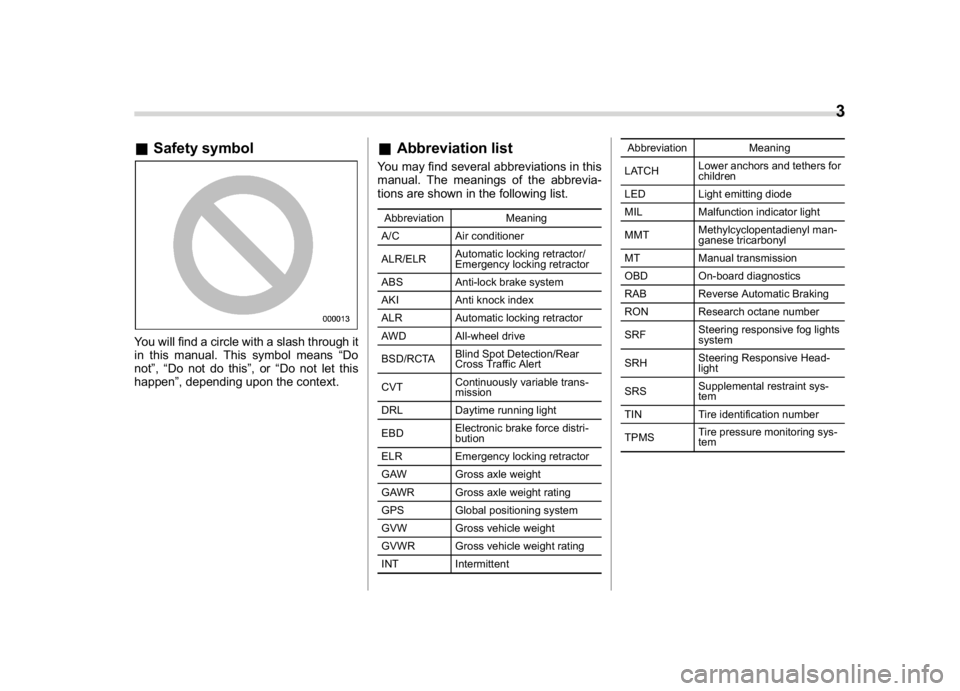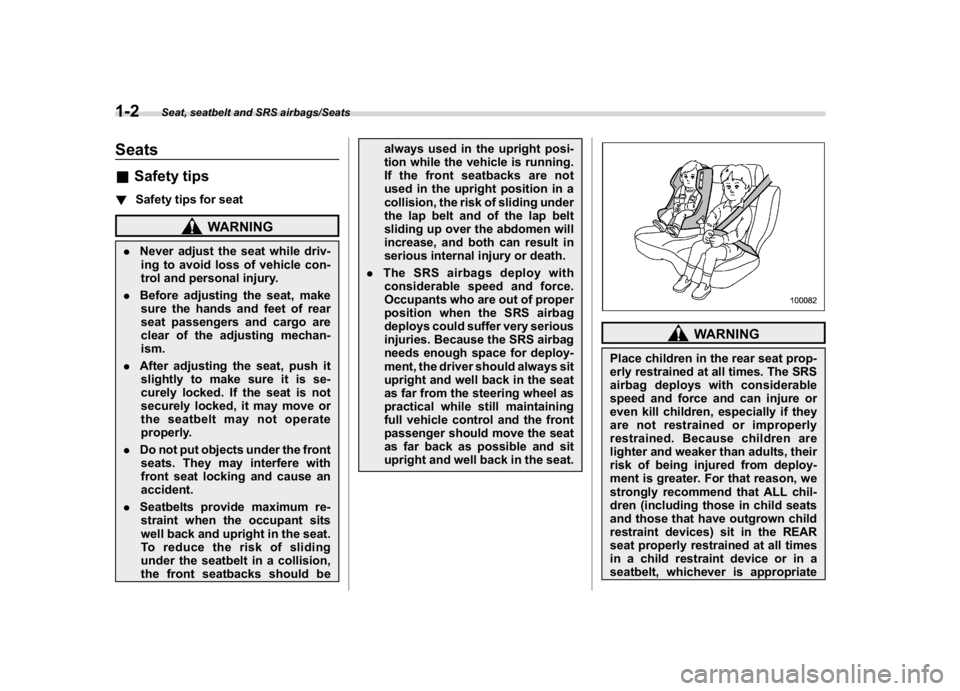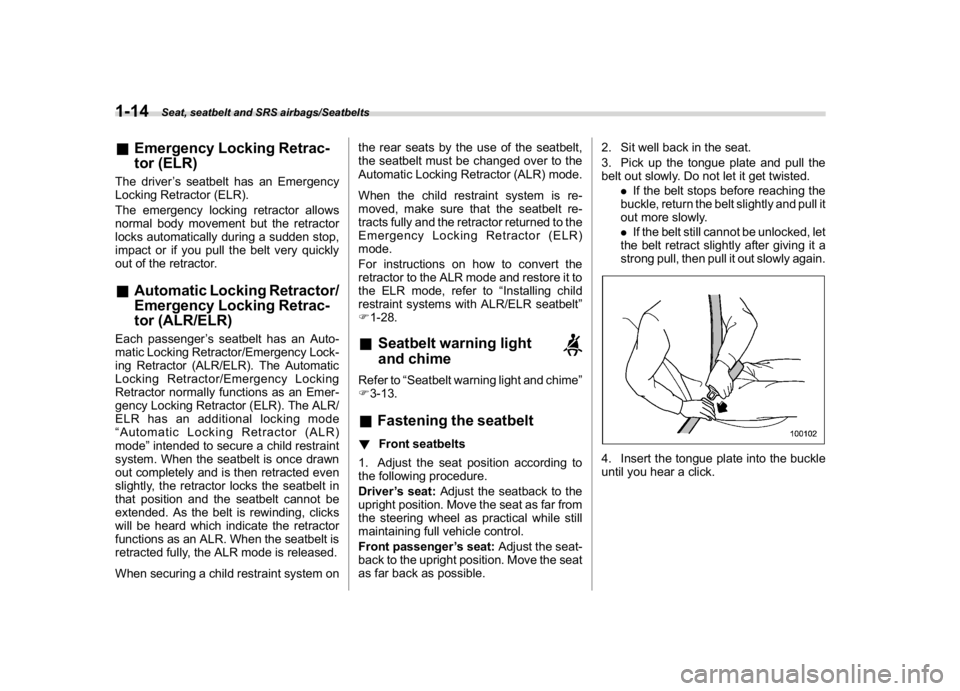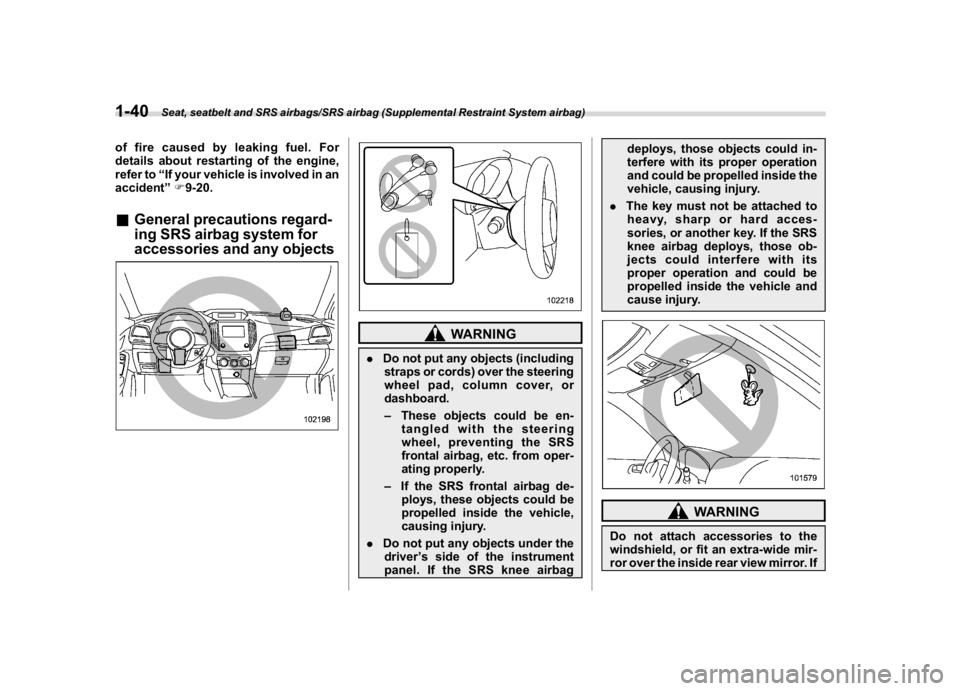2018 SUBARU CROSSTREK steering wheel
[x] Cancel search: steering wheelPage 6 of 474

(5,1)
北米Model "A1320BE-C" EDITED: 2017/ 10/ 10
&Safety symbolYou will find a circle with a slash through it
in this manual. This symbol means“Do
not”,“Do not do this”,or“Do not let this
happen”, depending upon the context.
&Abbreviation listYou may find several abbreviations in this
manual. The meanings of the abbrevia-
tions are shown in the following list.Abbreviation Meaning
A/C Air conditioner
ALR/ELRAutomatic locking retractor/
Emergency locking retractor
ABS Anti-lock brake system
AKI Anti knock index
ALR Automatic locking retractor
AWD All-wheel drive
BSD/RCTABlind Spot Detection/Rear
Cross Traffic Alert
CVTContinuously variable trans-
mission
DRL Daytime running light
EBDElectronic brake force distri-
bution
ELR Emergency locking retractor
GAW Gross axle weight
GAWR Gross axle weight rating
GPS Global positioning system
GVW Gross vehicle weight
GVWR Gross vehicle weight rating
INT IntermittentAbbreviation Meaning
LATCHLower anchors and tethers for
children
LED Light emitting diode
MIL Malfunction indicator light
MMTMethylcyclopentadienyl man-
ganese tricarbonyl
MT Manual transmission
OBD On-board diagnostics
RAB Reverse Automatic Braking
RON Research octane number
SRFSteering responsive fog lights
system
SRHSteering Responsive Head-
light
SRSSupplemental restraint sys-
tem
TIN Tire identification number
TPMSTire pressure monitoring sys-
tem
3
0
Page 7 of 474

(6,1)
北米Model "A1320BE-C" EDITED: 2017/ 10/ 10
Vehicle symbolsThere are some of the symbols you may
see on your vehicle.
For warning and indicator lights, refer to
“Warning and indicator lights”F23.
Mark Name
WARNINGCAUTIONRead these instructions care-
fullyWear eye protectionBattery fluid contains sulfuric
acidKeep children awayKeep flames awayPrevent explosions
Safety precautions when
driving&Seatbelt and SRS airbag
WARNING
.All persons in the vehicle must
fasten their seatbelts BEFORE
the vehicle starts to move. Other-
wise, the possibility of serious
injury becomes greater in the
event of a sudden stop or acci-
dent.
.To obtain maximum protection in
the event of an accident, the
driver and all passengers must
always wear seatbelts when in
the vehicle. The SRS (Supple-
mental Restraint System) airbag
does not do away with the need to
fasten seatbelts. In combination
with the seatbelts, it offers the
best combined protection in case
of a serious accident.
Not wearing a seatbelt increases
the chance of severe injury or
death in a crash even when the
vehicle has the SRS airbag..The SRS airbags deploy with
considerable speed and force.
Occupants who are out of proper
position when the SRS airbag
deploys could suffer very serious
injuries. Because the SRS airbag
needs enough space for deploy-
ment, the driver should always sit
upright and well back in the seat
as far from the steering wheel as
practical while still maintaining
full vehicle control and the front
passenger should move the seat
as far back as possible and sit
upright and well back in the seat.
For instructions and precautions, carefully
read the following sections.
.For the seatbelt system, refer to“Seat-
belts”F1-12.
.For the SRS airbag system, refer to
“SRS airbag (Supplemental Restraint Sys-
tem airbag)”F1-37.
&Child safety
WARNING
.Never hold a child on your lap or
in your arms while the vehicle is
moving. The passenger cannot
protect the child from injury in a
4
Page 20 of 474

(19,1)
北米Model "A1320BE-C" EDITED: 2017/ 10/ 10
1) Audio control switches*
2) INFO button for type A multi-function
display (black and white) (page 3-42)/
INFO button for type B multi-function
display (color LCD) (page 3-47)
3) Cruise control (page 7-48)
4) Shift paddle (page 7-26)
5) Heated Steering Wheel switch (page 3-
91)
6) SRS airbag (page 1-37)
7) Horn (page 3-92)
8) Combination meter display (color LCD)
control switches (page 3-33)
9) Talk switch for voice command system*/
Hands-free phone switches**: For details about how to use the
switches, refer to the separate naviga-
tion/audio Owner’s Manual.
–CONTINUED–
17
0
Page 31 of 474

(32,1)
北米Model "A1320BE-C" EDITED: 2017/ 10/ 10
Seats&Safety tips!Safety tips for seat
WARNING
.Never adjust the seat while driv-
ing to avoid loss of vehicle con-
trol and personal injury.
.Before adjusting the seat, make
sure the hands and feet of rear
seat passengers and cargo are
clear of the adjusting mechan-
ism.
.After adjusting the seat, push it
slightly to make sure it is se-
curely locked. If the seat is not
securely locked, it may move or
the seatbelt may not operate
properly.
.Do not put objects under the front
seats. They may interfere with
front seat locking and cause an
accident.
.Seatbelts provide maximum re-
straint when the occupant sits
well back and upright in the seat.
To reduce the risk of sliding
under the seatbelt in a collision,
the front seatbacks should bealways used in the upright posi-
tion while the vehicle is running.
If the front seatbacks are not
used in the upright position in a
collision, the risk of sliding under
the lap belt and of the lap belt
sliding up over the abdomen will
increase, and both can result in
serious internal injury or death.
.The SRS airbags deploy with
considerable speed and force.
Occupants who are out of proper
position when the SRS airbag
deploys could suffer very serious
injuries. Because the SRS airbag
needs enough space for deploy-
ment, the driver should always sit
upright and well back in the seat
as far from the steering wheel as
practical while still maintaining
full vehicle control and the front
passenger should move the seat
as far back as possible and sit
upright and well back in the seat.
WARNING
Place children in the rear seat prop-
erly restrained at all times. The SRS
airbag deploys with considerable
speed and force and can injure or
even kill children, especially if they
are not restrained or improperly
restrained. Because children are
lighter and weaker than adults, their
risk of being injured from deploy-
ment is greater. For that reason, we
strongly recommend that ALL chil-
dren (including those in child seats
and those that have outgrown child
restraint devices) sit in the REAR
seat properly restrained at all times
in a child restraint device or in a
seatbelt, whichever is appropriate
Seat, seatbelt and SRS airbags/Seats
1-2
Page 43 of 474

(44,1)
北米Model "A1320BE-C" EDITED: 2017/ 10/ 10
&Emergency Locking Retrac-
tor (ELR)The driver’s seatbelt has an Emergency
Locking Retractor (ELR).
The emergency locking retractor allows
normal body movement but the retractor
locks automatically during a sudden stop,
impact or if you pull the belt very quickly
out of the retractor.&Automatic Locking Retractor/
Emergency Locking Retrac-
tor (ALR/ELR)Each passenger’s seatbelt has an Auto-
matic Locking Retractor/Emergency Lock-
ing Retractor (ALR/ELR). The Automatic
Locking Retractor/Emergency Locking
Retractor normally functions as an Emer-
gency Locking Retractor (ELR). The ALR/
ELR has an additional locking mode
“Automatic Locking Retractor (ALR)
mode”intended to secure a child restraint
system. When the seatbelt is once drawn
out completely and is then retracted even
slightly, the retractor locks the seatbelt in
that position and the seatbelt cannot be
extended. As the belt is rewinding, clicks
will be heard which indicate the retractor
functions as an ALR. When the seatbelt is
retracted fully, the ALR mode is released.
When securing a child restraint system onthe rear seats by the use of the seatbelt,
the seatbelt must be changed over to the
Automatic Locking Retractor (ALR) mode.
When the child restraint system is re-
moved, make sure that the seatbelt re-
tracts fully and the retractor returned to the
Emergency Locking Retractor (ELR)
mode.
For instructions on how to convert the
retractor to the ALR mode and restore it to
the ELR mode, refer to“Installing child
restraint systems with ALR/ELR seatbelt”
F1-28.
&Seatbelt warning light
and chimeRefer to“Seatbelt warning light and chime”
F3-13.&Fastening the seatbelt!Front seatbelts
1. Adjust the seat position according to
the following procedure.
Driver’s seat:Adjust the seatback to the
upright position. Move the seat as far from
the steering wheel as practical while still
maintaining full vehicle control.
Front passenger’s seat:Adjust the seat-
back to the upright position. Move the seat
as far back as possible.2. Sit well back in the seat.
3. Pick up the tongue plate and pull the
belt out slowly. Do not let it get twisted.
.If the belt stops before reaching the
buckle, return the belt slightly and pull it
out more slowly.
.If the belt still cannot be unlocked, let
the belt retract slightly after giving it a
strong pull, then pull it out slowly again.
4. Insert the tongue plate into the buckle
until you hear a click.
Seat, seatbelt and SRS airbags/Seatbelts
1-14
Page 67 of 474

(68,1)
北米Model "A1320BE-C" EDITED: 2017/ 10/ 10
&General precautions regard-
ing SRS airbag system
WARNING
.To obtain maximum protection in
the event of an accident, the
driver and all passengers must
always wear seatbelts when in
the vehicle. The SRS airbag is
designed only to be a supplement
to the primary protection pro-
vided by the seatbelt. It does not
eliminate the need to fasten seat-
belts. In combination with the
seatbelts, it offers the best com-
bined protection in case of a
serious accident.
Not wearing a seatbelt increases
the chance of severe injury or
death in a crash even when the
vehicle has the SRS airbag.
For instructions and precautions
concerning the seatbelt system,
refer to“Seatbelts”F1-12.
.The SRS side airbag and SRS
curtain airbag are designed only
to be a supplement to the primary
protection provided by the seat-
belt. They do not eliminate the
need to fasten seatbelts. It is also
important to wear your seatbelt tohelp avoid injuries that can result
when an occupant is not seated
in a proper upright position.
WARNING
.The SRS airbags deploy with
considerable speed and force.
Occupants who are out of proper
position when the SRS airbag
deploys could suffer very serious
injuries. Because the SRS airbag
needs enough space for deploy-
ment, the driver should always sit
upright and well back in the seat
as far from the steering wheel as
practical while still maintaining
full vehicle control and the front
passenger should move the seatas far back as possible and sit
upright and well back in the seat.
WARNING
.Do not sit or lean unnecessarily
close to either front door. The
SRS side airbags are stored in
both front seat seatbacks next to
the door, and they provide pro-
tection by deploying rapidly (fas-
ter than the blink of an eye) in the
event of a side impact or frontal
collision. However, the force of
SRS side airbag deployment may
cause injuries if your head or
other parts of the body are too
close to the SRS side airbag.
Seat, seatbelt and SRS airbags/SRS airbag (Supplemental Restraint System airbag)
1-38
Page 69 of 474

(70,1)
北米Model "A1320BE-C" EDITED: 2017/ 10/ 10
of fire caused by leaking fuel. For
details about restarting of the engine,
refer to“If your vehicle is involved in an
accident”F9-20.&General precautions regard-
ing SRS airbag system for
accessories and any objects
WARNING
.Do not put any objects (including
straps or cords) over the steering
wheel pad, column cover, or
dashboard.
–These objects could be en-
tangled with the steering
wheel, preventing the SRS
frontal airbag, etc. from oper-
ating properly.
–If the SRS frontal airbag de-
ploys, these objects could be
propelled inside the vehicle,
causing injury.
.Do not put any objects under the
driver’s side of the instrument
panel. If the SRS knee airbagdeploys, those objects could in-
terfere with its proper operation
and could be propelled inside the
vehicle, causing injury.
.The key must not be attached to
heavy, sharp or hard acces-
sories, or another key. If the SRS
knee airbag deploys, those ob-
jects could interfere with its
proper operation and could be
propelled inside the vehicle and
cause injury.
WARNING
Do not attach accessories to the
windshield, or fit an extra-wide mir-
ror over the inside rear view mirror. If
Seat, seatbelt and SRS airbags/SRS airbag (Supplemental Restraint System airbag)
1-40
Page 74 of 474

(75,1)
北米Model "A1320BE-C" EDITED: 2017/ 10/ 10
&Components1) Driver’s SRS frontal airbag
2) Front passenger’s SRS frontal airbag
3) SRS side airbag
4) SRS curtain airbag
5) SRS knee airbag
The SRS airbags are stowed in the
following locations.
Driver’s SRS frontal airbag: in the center
portion of the steering wheel
A“SRS AIRBAG”mark is located at the
pad of the airbag.
Front passenger’s SRS frontal airbag:
near the top of the dashboard under the
“SRS AIRBAG”mark
SRS side airbag: in the door side of each
front seat seatback which bears an“SRS
AIRBAG”label
SRS curtain airbag: in the roof side
(between the front pillar and a point behind
the rear quarter glass)
“SRS AIRBAG”marks are located at the
top of each center pillar.
SRS knee airbag: under the steering
column
A“SRS AIRBAG”mark is located at the
door of the airbag.
–CONTINUED–
Seat, seatbelt and SRS airbags/SRS airbag (Supplemental Restraint System airbag)
1-45
1